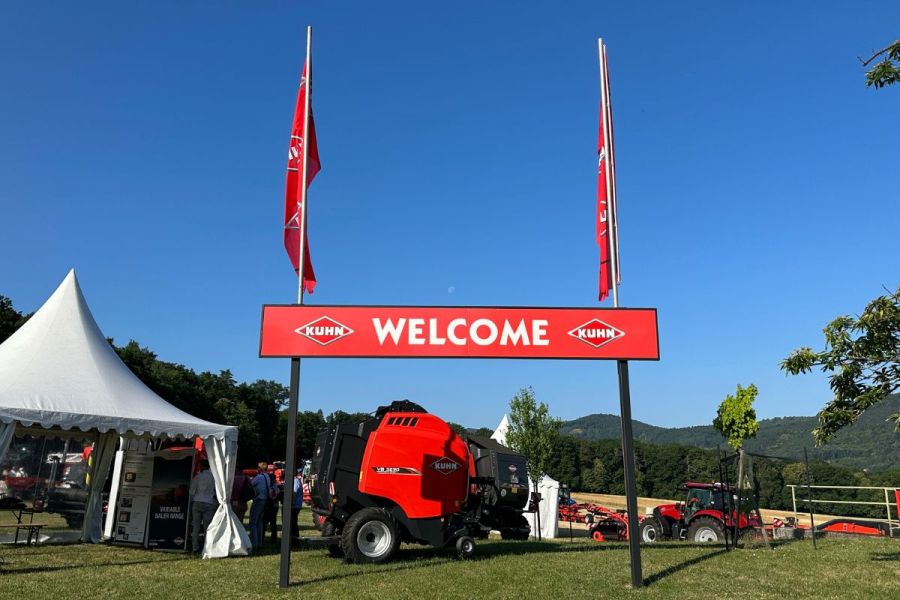Kuhn’s forward trajectory hasn’t been hindered by the challenges of the past few years but has instead given the firm direction, which can be seen through its portfolio of new releases. CPM headed to France to see first-hand.
By Melanie Jenkins
Four eventful years have passed since the last time Kuhn held an international conference at its Centre for Progress in Saverne, France, but during that time the company certainly hasn’t sat on its laurels. Early July saw CPM return to the picturesque countryside at the foot of the Vosges mountains to see just what Kuhn has been working on.
Balers
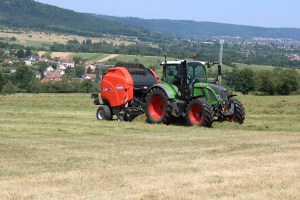
The VB 3285 is part of Kuhn’s Strong range of balers and has a bale diameter ranging from 1.65m-1.85m.
A new addition to Kuhn’s stable is its range of VB 3200 series balers, consisting of Strong, Pro and Ultimate models. “The balers come from developments to our previous 3100 series,” explains the company’s Rhodri Jenkins.
The VB 3255 and VB 3285 make up the Strong range and have a bale diameter ranging from 0.80-1.65m and 0.80m-1.85m, respectively. “There are a number of different intake options available on these machines, from a direct feed through to Optifeed integral rotor or the Opticut 14,” says Rhodri. “The Strong models are designed for the farmer who is baling mostly straw and hay.”
The Pro range is made up of the VB 3260 and VB 3290, with bale sizes up to 1.6m and 1.85m, respectively. These machines can have either the Opticut 23 knife intake, the Opticut 14 or the Optifeed. “The machine is designed for all crop types, from straw to hay to grass silage, and is targeted at the large-scale farmer or contractor looking to maximise the number of bales per year and density.”
These models have a 10% higher capacity than the 3100 models due to a larger roller on the front of the pick-up, along with spring-loaded crop tines to add more pre-compression on the crop as it goes through the rotor, explains Rhodri.
The premium range consists of the Ultimate, which includes the VB 7160 and VB 7190, again with bale sizes up to 1.65m and 1.85m and comes with the same intake integral rotor options as the Pro range. “These are contractor machines, where maximising density, capacity and return on investment are important,” he says.
In addition, a VBP 3260 and 3290 baler wrapper combination range is available. “These models include the larger crop roller, and at the rear of the machine is a ‘hold-to-run’ button, which allows operators changing a roll of film to get the satellite to turn and join onto the bale without having to go into the cab to do so,” explains Rhodri.
The machines are capable of a 15% quicker bale transfer time as a result of an increased tailgate speed and are equipped with new wrapper functionalities such as automatic unloading of (straw) bales in pairs.
A new system available this year on all VB 3200 models is the Progressive Density Plus, which allows these balers to achieve a 10% higher density in solo balers than the 3100 range. An extra hydraulic valve on the baler exerts higher pressure to create this greater density, but this is designed for drier crops.
Strong balers don’t come ISOBUS ready, however it comes as standard in the Pro and Ultimate models but can be specified without.
Cultivation equipment

The Optimer XL has 620mm discs and is designed to incorporate more trash, or for cover crop destruction, and can comfortably work down to depths of 15cm.
Kuhn offers two variants to its Optimer range, the L and XL. This line has been around for a number of years, but now new updates are aiming to provide better performance on farm.
The Optimer stubble cultivator is designed for fine soil preparation before seeding and comes in mounted versions of 3m and 4m, and then trailed versions come in 4m, 5m, 6m, 7.5m, 9m, 12m and now a new 12.5m model. The 12.5m is suited to controlled traffic systems and is available on the L, with an XL model in the pipeline,” explains the firm’s David Rose.
“The Optimer L has a smaller 510mm disc which is designed to work between 3-10cm deep, so it’s for stale seedbed preparation,” he says. “The XL version has 620mm discs and is designed to incorporate more trash, or for cover crop destruction, and can comfortably work down to depths of 15cm.”
There are multiple attachment options, including to the lower links via the cross shaft, but a K80 ball hitch or various ring hitches can also be specified.
The drawbar has a hydraulic ram to make it easy to adapt to the tractor. “We recommend front gauge wheels on the wider machines, which are then linked with the drawbar.
New for this season, the machine can also be fitted with front mounted implements before the discs, such as a levelling board or chopping rollers, which can be used in dense vegetation or behind high stubbles such as sunflowers or oilseed rape. With a small diameter and high rotation speed, these can cut through foliage upstream of the cultivator with the aim of increasing the machine’s passage capacity and to create quicker plant break-down for faster mineralisation. These can be fitted on the 4m, 5m, 6m and 7.5m models, but not on mounted machines.
The machine has a 90cm underframe clearance to help it cope with high residue volumes. The discs have a conical profile, meaning that as they wear, they maintain the same working angle and soil penetration. An optional tine harrow can be fitted behind the disc to evenly distribute any crop residue, or it can create a finer soil.
At the rear, there’s the option of nine different rollers depending on working conditions and the desired objective. For example, the HD liner roller is targeted at a high level of consolidation which is important if running the machine with a seeder. This roller can also be used in a wide range of conditions. It’s also possible to add a further harrow at the rear of the roller to aid crop destruction, says David.
In the transport position, the machine is designed to be compact and stable with a low centre of gravity, and like all the other Optimer models, has a road width of 3m and height of 4m. It can be fully unfolded and put into work configuration by operating a spool valve in the cab. When it’s fully unfolded, it’s carried on its roller and gauge wheels for stability and manoeuvrability.
The Optimer 12500 is fitted with 100 discs, each with a diameter of 510mm. One of the main features of the stubble cultivator is that it has one of the largest underframe clearances on the market.
All Optimers can have an SH air seeder system fitted, either 200-litre, 400-litre or 600-litre options, and can be ISOBUS or non ISOBUS controlled.
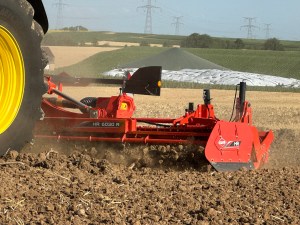
Kuhn’s HR foldable power harrow is capable of working independently or in combination with a seedbar.
Kuhn’s HR foldable power harrow is capable of working independently or in combination with a seedbar. Coming in three models, the 4030 RCS, 4530 RCS and 5030 RCS, it can have working widths from 4-5m. The machines are suited to tractors up to 300hp, but this goes up to 350hp for the 5m model.
The central Duplex gearbox is protected against overheating by an oil cooler. The built-in pump is activated automatically with the PTO, so the user doesn’t have to think about switching it on. The whole drive chain is protected against overloads by a cut-out clutch.
The working-depth and levelling-bar settings are hydraulic, as standard, and adapt to the soil texture and desired results, in real time.
The power harrows are compatible with the Steelliner and Megapacker rollers. These large-diameter rollers are designed to provide effective tamping and load distributing capacities.
Spraying technology
There is a further development to Kuhn’s Lexis trailed sprayer range with the 3800. The important aspect of this machine is that it has 4000-litre capacity, and it comes with booms of 18-28m,” says the company’s Julian Plank.
Another notable element is the machine’s compaction, he adds. “It’s 4.3m in length from hitch to axle and 2.55m in width and is just over 3t unladen. It comes with a steering drawbar and Track Assist as an option, and the workstation can either be the manual Manuset or assisted Diluset+ setup.”
The boom comes with CCE (continuous circulation electric), AutoSpray and Boom Assist, and also uses the ISOBUS CCI Connect terminals.
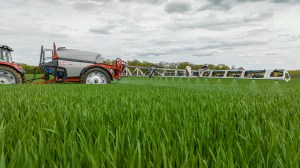
Booms on the Lexis 3800 include Kuhn Equilibra suspension technology which reacts to the way the boom moves, aiming to give three dimensional stability.
Booms on this machine includes Kuhn Equilibra suspension technology which reacts to the way the boom moves, aiming to give three-dimensional stability and keep it parallel to the chassis.
Kuhn’s Metris 2 trailed sprayer now comes with a new LEH (large equilibria hybrid) boom, with a steel and aluminium concept, says Julian. “The first section is steel for rigidity and the second is aluminium for strength and lightness.”
Technology on the boom includes AutoSpray, MultiSpray and iSpray, with new lighter, smaller cameras that sit inside it. “The idea of these is that we can target the weeds specifically.”
The sprayer now comes with VF tyres to help reduce ground compaction and provide some level of suspension.
There are now a number of levels of Boom Assist available, including Slant Pro, Total Pro and Extreme. Pro stands for proportional, and as with Slant Pro, two ultrasonic sensors control boom height and slant. Whereas on Total Pro, three ultrasonic sensors control height and correct boom geometry. Boom Assist Extreme has three ultrasonic sensors to control height, slant and variable geometry.
Another recent addition is Kuhn’s F40 Evo self-propelled sprayer with a front mounted boom, which is a lead seller in France and is being rolled out across Europe, but at this point in time is not heading to the UK, explains Julian.
Fertiliser spreaders
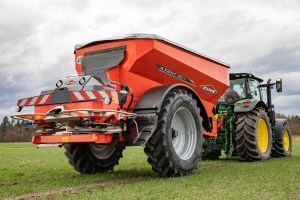
With a 9400-litre hopper capacity, the Axent 90.1 can spread up to 400kg/ha over 36m at more than 20km/h but can also work at widths of up to 50m.
Kuhn has completed its range of centrifugal fertiliser spreaders with the new large, trailed model, the Axent 90.1. With a 9400-litre hopper capacity, this machine can spread up to 400kg/ha over 36m at more than 20km/h but can also work at widths of up to 50m, says Kuhn’s Alexis Heintz.
The 90.1 is equipped with the Axis Power Pack spreading module with mechanical drive, so a low hydraulic flow is sufficient to power the conveyor belt and is adapted from tractors above 180hp.
The machine comes with EMC (Electronic Massflow Control), which makes it possible to adjust the application rate, independently and automatically on the left and right, every second. It also has a CDA (Coaxial Distribution Adjustment) distribution system to increase spreading precision and consistency despite variations in application rate, working width, and ground speed.
It also comes with VariSpread 8, where the rate of fertiliser can be reduced progressively over eight sections or VariSpread Pro section control, which consists of two electric motors called SpeedServos, that enable a high-speed and continuous working width adjustment by modifying the drop points and the fertiliser application rate over one-metre sections, says Alexis. VariSpread allows stepless variable working widths at high speeds.
Fertiliser spreaders in the Axis and Axent range can now be equipped with Kuhn’s new GSE Pro border spreading limiter, which replaces the existing GSE. There are two versions available, including the GSE 30 and the GSE 50.
The GSE 30 PRO is adapted to AXIS 20.2, 30.2 and 40.2 fertiliser spreaders with working widths from 12-42m, according to the model. The GSE 50 PRO is designed for the AXIS 50.2 fertiliser spreader and the AXENT 100.1 trailed tool which can reach working widths of 50m.
“The goal is to bring even more precision at the field border,” explains Alexis. “A hydraulic limiter controlled from the tractor cab means spreading is only carried out towards the plot, while a deflector prevents granules from crossing the border.
“In the new versions, there are longer wings and extensions which retract automatically for storage,” says Alexis. “There are new deflectors so less than three out of 1000 granules go over the border.”
Digital
The new ISOBUS VTI 60 Terminal completes Kuhn’s range of terminals with this compatibility. “The target is to have a large display with colour touchscreen and 12 hard keys in addition to the soft keys,” explains Kuhn’s Vincent Gerard. The new terminal has a 14.5cm screen and fits between the VT 30 and CCI 800 terminal.
This terminal is suited to conventional control functions for the various machines or as an additional terminal to extend the operator’s in-cab display area, but for those aiming for precision farming and GPS automation solutions, the CCI 800 or CCI 1200 terminals are better suited.
Autonomous preview
Feeding attendees a baited hook, Kuhn’s Thierry Krier introduced a teaser of its new autonomous machine, Karl. The firm has been schtum on what Karl is or the tasks it’ll be able to perform, but has given a few clues as to the area it’ll likely be targeted at.
“We’ve been working on the ideas of autonomous farming for field use and crop production,” he said. “We’ve developed four generations of machine and a few years ago we managed to run three machines autonomously working in harmony across 50ha to do five different operations. And now, we present Karl, which is our response to autonomous farming in crop production. It’s not just a robot, it’s a lot more and to our knowledge there’s nothing available like it yet.”
But for those wanting to find out more, they’ll will have to wait to see a full preview of the machine at Agritechnica in Hanover, Germany on 12-18 November.
This article was taken from the latest issue of CPM. For more articles like this, subscribe here.
Sign up for Crop Production Magazine’s FREE e-newsletter here.

